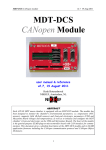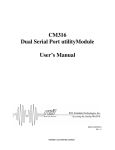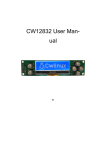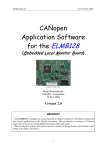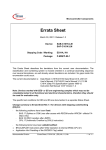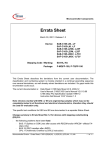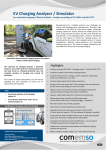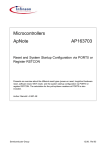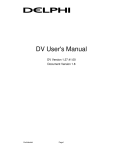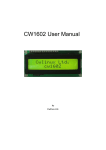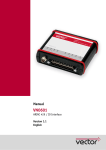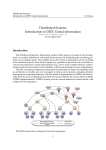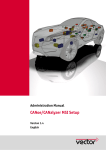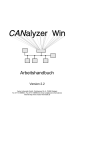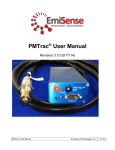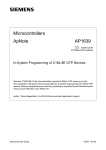Download Microcontrollers ApNote AP2922
Transcript
Microcontrollers ApNote AP2922 additional file AP292201.EXE available ‘C’ CAN Driver Routines for the C166 Family This application note describes CAN protocol driver software routines written in ‘C’ for the members of the Siemens 16-bit microcontroller family C166 which are equipped with an on-chip CAN module (e.g. C167CR, C164CI). Authors: Axel Wolf / SCI Cupertino ICD - Dr. Jens Barrenscheen / HL MC PD 8 Semiconductor Group 05.97, Rel. 01 ’C’ CAN Driver Routines for the C166 family 1 Introduction....................................................................................................................3 1.1 Abstract.........................................................................................................................3 1.2 CAN Driver Routines Overview ....................................................................................3 1.3 Files included in the CAN Driver ApNote......................................................................4 1.4 Global Variables used by the Driver Routines..............................................................4 1.5 Notes concerning this ApNote ......................................................................................5 2 Routine #1: Initialization Procedure for the CAN Module...........................................7 3 Routine #2: Configuring a Message Object of the CAN Module..............................10 4 Routine #3: Load the data bytes of a Message Object.............................................13 5 Routine #4: Read the data bytes of a Message Object (1..14) .................................15 6 Routine #5: Read out Message Object 15 (Basic CAN Message Object) ...............17 7 Routine #6: Send a Message Object ..........................................................................20 8 Routine #7: Check a Message Object (1..14) for new data ......................................22 9 Routine #8: Check Message Object 15 for new data or new remote frame............24 10 Routine #9: Check for a Bus Off Situation in the CAN Module..............................25 11 Hints concerning the CAN Library CAN16X1.LIB....................................................26 12 Hints concerning the Example Programs................................................................26 13 Hints concerning the Interrupt Service Routine CISR16X1.C ................................30 14 Hints concerning the Header File CREG_16X.H......................................................33 15 Hints concerning the CANalyzer Configuration Files (*.CFG) ...............................33 AP2922 ApNote - Revision History Actual Revision : Rel.01 Previous Revision: --Page of Page of Subjects changes since last release) actual Rel. prev. Rel. Semiconductor Group 2 of 33 AP2922 05.97 ’C’ CAN Driver Routines for the C166 family 1 Introduction 1.1 Abstract This application note describes CAN protocol driver software routines for the members of the Siemens 16-bit microcontroller family C166 which are equipped with an on-chip CAN module (e.g. C167CR, C164CI). Whilst every effort has been made to ensure the accuracy of information contained in this application note, the authors cannot be held responsible for any consequences arising from its use. Please report comments, suggestions for improvement etc. to: [email protected]. For further information concerning the on-chip CAN module on the C166 devices or the C166 microcontroller itself, please refer to the document “Description of the on-chip CAN module” and the respective derivative’s User’s Manual. For further information concerning the CAN protocol, Siemens’ CAN devices and additional CAN ApNotes, please refer to − http://www.sci.siemens.com/can.html For further information concerning Siemens’ Microcontrollers, please refer to − http://www.sci.siemens.com/ (select the microcontrollers) − http://www.siemens.de/Semiconductor/products/products.htm (select the MC’s) 1.2 CAN Driver Routines Overview The following table shows an overview of the included CAN driver routines Table 1-1: Included driver routines Initialization routine for the CAN module: init_can_16x(..) Define a message object in the CAN module: def_mo_16x(..) Load the data bytes of a message object: ld_modata_16x(..) Read the data bytes of a message object: rd_modata_16x(..) Read the contents of message object 15: rd_mo15_16x(..) Send message object send_mo_16x(..) Check for new data in a message object: check_mo_16x(..) Check for new data or remote frame in message object check_mo15_16x(..) 15: Check if a bus off situation has occurred and recover check_busoff_16x(..) from bus off: Semiconductor Group 3 of 33 AP2922 05.97 ’C’ CAN Driver Routines for the C166 family 1.3 Files included in the CAN driver ApNote Table 2 shows all the files that are part of this ApNote. You will find them in the additional file AP292201.EXE. Table 1-2: Files belonging to this ApNote Name CAN16X1.LIB EXS_16X1.C, EXX_16X1.C, EXI_16X1.C CISR16X1.C CREG_16X.H EXS_16X1.CFG, EXX_16X1.CFG 1.4 Explanation CAN Library CAN driver routine library to be linked to your application programs. See also section 11. Example programs Gives an idea of how to use the CAN driver routines in your application. Just standard CAN (11-bit identifier) messages are used in EXS_16X1.C, standard and extended (29-bit) messages are used in EXX_16X1.C. Interrupts are evaluated when using EXI_16X1.C plus CAN interrupt service routine CISR16X1.C. See section 12 for details. CAN Interrupt service routine Can be used together with EXI_16X1.C to evaluate interrupts of the CAN module. See section 13 for details. Header File Include file for the declaration of the Control Registers of the CAN module. Is included in some of the source files and in the CAN interrupt service routine (see also section 14). CANalyzer Configuration files If you have a Windows-based Vector/Softing CANalyzer, this configuration file is prepared to communicate with the example programs mentioned above. EXS16X1.CFG works together with EXS_16X1.C and EXI_16X1.C. EXX_16X1.CFG works together with EXX_16X1.C. See section 15 for details. Global Variables used by the Driver Routines The global variables used by the CAN driver routines can be found in table 3. These variables can not be accessed via the example programs, though. Semiconductor Group 4 of 33 AP2922 05.97 ’C’ CAN Driver Routines for the C166 family Table 1-3: Global variables used by the CAN driver routines Name id_ptr_16x[16] Type unsigned int * db0_ptr_16x[16] unsigned char * msg_ctrl_ptr_16x[16 ] unsigned int * msg_conf_ptr_16x[16 ] unsigned char * dir_bit_16x[16] unsigned char xtd_bit_16x[16] unsigned char dlc_16x[16] unsigned char 1.5 Task Field of 16 pointers (only [1]…[15] are used) to the Upper Arbitration Registers of the message objects 1..15. Field of 16 pointers (only [1]..[15] are used) to the data byte 0 of the message objects 1..15. Field of 16 pointers (only [1]..[15] are used) to the Message Control Registers of message objects 1..15. Field of 16 pointers (only [1]..[15] are used) to the Message Configuration Registers of message objects 1..15. Field of 16 chars (only [1]..[15] are used) which contain a copy of the direction bits of the message objects 1..15. Field of 16 chars (only [1]..[15] are used) which contain a copy of the extend bits of the message objects 1..15. Field of 16 chars (only [1]..[15] are used) which contain a copy of the data length code of the message objects 1..15. Notes concerning this ApNote Before using the CAN driver software, please read the following notes. • The CAN example programs have been compiled and tested with the BSO/Tasking compiler C166. To make compilations with other compilers easier, the routines don’t really use BSO/Tasking specific code. Still slight changes may be necessary to compile them with an other C166 family compiler. • In the additional file AP292201.EXE, you will find all the files discussed in this ApNote (source files for the routines, example programs, interrupt service routine etc.) • At least in this first version of this ApNote, the 16x CAN driver routines are written in a way that they can be easily ported to other C166 compilers or even to the 8-bit world to be used together with the Siemens 8-bit derivatives with integrated CAN module (e.g. C505C, C515C). The routines are furthermore designed for easy handling of the CAN module by the user. They do not claim to be optimized for small code generation or fast execution speed. Semiconductor Group 5 of 33 AP2922 05.97 ’C’ CAN Driver Routines for the C166 family • Nevertheless, the names of the driver procedures / functions and all other files included in this ApNote contain the letters “16X” to differentiate between the different CAN driver ApNotes that are available (or planned) for other Siemens CAN components: Table 1-4: Differentiation between files belonging to different ApNotes Name includes… Explanation: 16X CAN drivers for C166 family 500 CAN drivers for C500 family 92 CAN drivers for Siemens standalone CAN controller 81C92 91 CAN drivers for Siemens standalone CAN controllers 81C91/90 • The CAN driver routines in this ApNote use two different approaches of accessing the CAN registers. For the general CAN control registers, on-the-fly casting from near address to pointers is used. The registers within the message objects, however, are accessed by proper pointer types. • For best efficiency, execute the driver routines in segment 0 of the memory (first 64k code segment). • Within the routines very often the pointers e.g. to the data bytes are copied into a local dummy pointer so that the original pointer remains untouched during the routine (e.g. in a loop). • The send_mo_16x procedure won’t work without having defined a message object (def_mo_16x) AND having specified the data bytes with ld_mo_16x to prevent the transmission of invalid data. Semiconductor Group 6 of 33 AP2922 05.97 ’C’ CAN Driver Routines for the C166 family 2 Routine #1: Initialization Procedure for the CAN Module Table 2-1: Procedure overview Procedure name: init_can_16x(P1, P2, P3, P4) Task: initialize the global registers of the CAN module Input parameters: P1..P4 (see below) Returns: --- Name of C-source file: INCAN16X.C Table 2-2: Input parameters No Meaning Type P1 baud rate [kbit/s] unsigned int P2 EIE bit unsigned char P3 P4 SIE bit IE bit unsigned char unsigned char Possible values 50, 125, 250, 500, 1000 0: Effect 1: 0: • • 1: 0: • • 1: • Bit timing register will be loaded with the values corresponding to the selected baud rate • No error interrupts are generated from the CAN module to the C16x CPU. Error interrupts are enabled. No status interrupts are generated from the CAN module to the C16x CPU. Status interrupts are enabled. Interrupt line from the CAN module to the C16x CPU is disabled. Interrupt line enabled. Calling example: init_can_16x( Semiconductor Group 1000, 0, 0, 1); CAN interrupts enabled no status interrupts no error interrupts Baud rate 1 Mbit/s 7 of 33 AP2922 05.97 ’C’ CAN Driver Routines for the C166 family Table 2-3: Local variables Name Type baud_rate unsigned char unsigned char unsigned char unsigned char unsigned char unsigned char * eie sie ie i, n dummy_dbptr Corresp. Input parameter P1 Task P2 holds error interrupt enable (1) / disable (0) P3 holds status interrupt enable (1) / disable (0) P4 holds general CAN interrupt enable (1) / disable (0) loop variables ----- holds selected baud rate is loaded with db0_ptr_16x[i] in the procedure. Used to reset all data bytes in all message objects. Additional Information: This will be the first procedure called in the main program. The procedure performs the following actions: • • • Set port pin P4.6 (CAN TxD) to output Set port pin P4.5 (CAN RxD) to input Load above mentioned pointers to the different registers of the on-chip CAN module: After the “for” loop the pointers are set as follows: Table 2-4: Pointer Setting in procedure init_can_16x Pointer msg_ctrl_ptr_16x[n] Target Address EFn0H id_ptr_16x[n] EFn2H msg_conf_ptr_16x[n] EFn6H db0_ptr_16x[n] EFn7H Register located there Message Control Registers of message object n Upper Arbitration Register of MO n Message Configuration Registers of message object n Data byte 0 of message object n Please compare to the following figure: Semiconductor Group 8 of 33 AP2922 05.97 ’C’ CAN Driver Routines for the C166 family Message Control +0 Object Start Address +2 Arbitration Data0 +4 Message Config. Msg. Config. +6 +6 +8 Data 7...0 +10 +12 Reserved +14 Figure 2-1: Message Object structure in the C167CR / C164CI • • • • • • • Clear the arrays dir_bit_16x[n], xtd_bit_16x[n], dlc_16x[n] Initialize the Bit Timing Register according to the specified baud rate Set the Global Masks in a way that for message objects 1..14 each bit of the standard / extended identifier of the incoming frame must match to store the message into the respective message object. Set the Mask of Last Message in a way that all messages which cannot be stored in message objects 1..14 are stored in message object 15 (enable Basic CAN feature). Set all message objects to NOT VALID. Set all data bytes in all message objects to 0. Set the user specified values for interrupt control (bits EIE, SIE, IE) in the Control Register (EF00H) Semiconductor Group 9 of 33 AP2922 05.97 ’C’ CAN Driver Routines for the C166 family 3 Routine #2: Configuring a Message Object of the CAN Module Table 3-1: Procedure overview Procedure name: def_mo_16x(P1, P2, P3, P4, P5, P6, P7) Task: configure one message object of the CAN module Input parameters: P1..P7 (see below) Returns: --- Name of C-source file: DEFMO16X.C Table 3-2: Input parameters No Meaning Type P1 # of message object to be configured eXTenD bit unsigned char P2 unsigned char P3 Message Identifier (HEX-code!) unsigned long P4 DIRection bit unsigned char Possible values 1..15 Effect 0: • 1: 0H …3FFH (std); 0H … 1FFFFFFFH (extended) 0: 1: P5 Specified message object (MO) will be configured and can then be used for CAN communication. MO will be configured for standard CAN (11-bit identifier). • Extended CAN (29-bit ID) is selected. Specified Identifier will be applied to the message object. The message object will the receive / transmit message which carry this specified identifier. • MO will be configured to receive data frames and transmit remote frames. • MO will be configured to transmit data frames and receive remote frames. Specifies length of the data field on transmission of the MO. Set to 0 for remote frames. unsigned char 0..8 P6 Data Length Code of MO to be configured TXIE bit unsigned char 0: 1: • • P7 RXIE bit unsigned char 0: 1: • • Semiconductor Group 10 of 33 MO will generate no transmit interrupts. MO will generate an interrupt on each successful transmission of a frame. MO will generate no receive interrupts. MO will generate an interrupt on each successful reception of a frame. AP2922 05.97 ’C’ CAN Driver Routines for the C166 family Calling example: def_mo_16x( 4, 0, 0x123, 1, 8, 0, 0 ); RXIE=0 TXIE=0 DLC=8 Transmit data frames Identifier Standard CAN MO (11-bit ID) MO number Table 3-3: Local variables Name Type nr unsigned char unsigned char unsigned long unsigned char xtd id dir dlc Corresp. input parameter P1 Task P2 holds specified XTD bit “1” = 29 bit ID; “0” = 11 bit ID holds specified identifier P3 P4 unsigned char unsigned char P5 rxie unsigned char P7 dummy_int unsigned int unsigned int * --- txie dummy_idptr Semiconductor Group P6 --- holds specified message object no. holds specified DIR bit “1” = transmit data frames, “0” = receive data frames holds specified data length code holds specified TXIE bit “1” = transmit interrupts enabled, “0” = transmit interrupts disabled holds specified RXIE bit “1” = receive interrupts enabled, “0” = receive interrupts disabled used to temporarily store 16 bit values is loaded with id_ptr_16x[i]+1 in the procedure which is the Lower Arbitration Register. Used to load this register. 11 of 33 AP2922 05.97 ’C’ CAN Driver Routines for the C166 family Additional Information: Before being able to transmit or receive any frame, the message objects that are going to be used must be configured which is done with this procedure. Only message object numbers between 1 and 15 are accepted. The procedure has to be called for each message object separately. The procedure performs the following actions: • • • • Check if the specified message object is valid (number between 1 and 15). Load the Upper Arbitration Register and the Lower Arbitration Register with the specified identifier value. Load the Message Control Register: - For transmit objects (DIR=1), CPUUPD is set. Therefore the message object can not yet be transmitted, because its data bytes do not yet contain valid values. Load the message object’s data bytes before transmitting (see next procedure). - For receive objects (DIR=0), there’s no CPUUPD field but this bit field is called MSGLST here (Message Lost). It will be reset by this procedure as no message has been lost so far. - Add the values specified for TXIE and RXIE to the Message Control Register. Load the Message Configuration Register with the values specified for DLC, DIR and XTD. Semiconductor Group 12 of 33 AP2922 05.97 ’C’ CAN Driver Routines for the C166 family 4 Routine #3: Load the data bytes of a Message Object Table 4-1: Procedure overview Procedure name: ld_modata_16x(P1, P2) Task: load the data bytes of one message object of the CAN module Input parameters: P1, P2 (see below) Returns: --- Name of C-source file: LDMOD16X.C Table 4-2: Input parameters No Meaning Type P1 # of message object address of an upload data array[8] unsigned char P2 address Possible values 1..14 Effect user specific 8byte buffer The data bytes of the specified MO will be filled with the contents of the 8-byte array whose start address (1st element) is passed on to this procedure. Data bytes of specified MO will be loaded. Calling example: ld_modata_16x( Semiconductor Group 4, upload_data_buf ); address of first element of 8-byte array previously filled with the data to be sent out (&upload_data_buf[0]) MO number 13 of 33 AP2922 05.97 ’C’ CAN Driver Routines for the C166 family Table 4-3: Local variables Name Type nr unsigned char unsigned char * upl_data_ptr Corresp. Input parameter P1 Task P2 is loaded with the address of the first element of the 8-byte array filled with the data to be sent. is loaded with db0_ptr_16x[nr] in the procedure. This is where the data will be copied. loop variable dummy_dbptr unsigned char * --- i uns. char --- holds specified message object Additional Information: Before being able to transmit any data frame, the message object’s data bytes have to be loaded at least once which can be done with this procedure. Please note that as MO 15 cannot be transmitted, its data bytes cannot be loaded with this procedure. Only message object numbers between 1 and 14 are accepted. The procedure has to be called for each message object separately. The procedure performs the following actions: • • • • Check if the specified message object is valid (number between 1 and 14). Set CPUUPD and NEWDAT in the Message Control Register of the specified message object to indicate that the CPU is actually working on the message object’s data. Copy data bytes from the upload buffer specified in input parameter P2 to the data bytes of the message object specified in input parameter P1. Reset CPUUPD in the Message Control Register to enable transmission of the message object. Semiconductor Group 14 of 33 AP2922 05.97 ’C’ CAN Driver Routines for the C166 family 5 Routine #4: Read the data bytes of a Message Object (1..14) Table 5-1: Procedure overview Procedure name: rd_modata_16x(P1, P2) Task: read the data bytes of one message object of the CAN module Input parameters: P1, P2 (see below) Returns: --- Name of C-source file: RDMOD16X.C Table 5-2: Input parameters No Meaning Type P1 # of message object address of a download data array[8] unsigned char P2 address Possible values 1..14 Effect user specific 8byte buffer The 8-byte array whose start address (1st element) is passed on to this procedure is filled with the data bytes of the specified MO. Data bytes of specified MO will be read. Calling example: rd_modata_16x( Semiconductor Group 4, download_data_buf ); address of first element of 8-byte array which shall be filled with the data bytes of the spec. message object MO number 15 of 33 AP2922 05.97 ’C’ CAN Driver Routines for the C166 family Table 5-3: Local variables Name Type nr unsigned char unsigned char * downl_data_ptr dummy_dbptr i dummy_char unsigned char * uns. char uns. char Corresp. input parameter P1 Task P2 is loaded with the address of the first element of the 8-byte array to be filled with the data bytes of the specified MO is loaded with db0_ptr_16x[nr] in the procedure. This is where the data will be copied from. loop variable used to temporarily store 8 bit values ------- holds specified message object Additional Information: This procedure is used to read the data bytes of a certain message object and copy them into a user specific 8-byte data buffer. Usually it will be called after the software has detected that new data has been written into a message object using the function check_mo_16x (see below). Please note that for MO 15 a separate procedure to read out this message object is available (see below). Only message object numbers between 1 and 14 are accepted. The procedure has to be called for each message object separately. The procedure performs the following actions: • • • • Check if the specified message object is valid (number between 1 and 14). Store the actual data length code of the new message into the global variable dlc_167[nr] Clear INTPND and NEWDAT in the Message Control Register of the specified message object in order to allow a new message to be written into this message object during this procedure is running Copy the data bytes (their number is specified by the actual dlc) from the message object specified in input parameter P1 to the download buffer specified in input parameter P2. At the end, the procedure is only left if NEWDAT has not been updated to 1, i.e. no new message has arrived for this message object during the execution of this procedure. If NEWDAT has been set to 1 again, the procedure is repeated. In this way, only the latest data bytes are returned. Semiconductor Group 16 of 33 AP2922 05.97 ’C’ CAN Driver Routines for the C166 family 6 Routine #5: Read out Message Object 15 (Basic CAN Message Object) Table 6-1: Procedure overview Procedure name: rd_mo15_16x(P1, P2, P3) Task: read message object 15 of the CAN module Input parameters: P1..P3 (see below) Returns: --- Name of C-source file: RDM1516X.C Table 6-2: Input parameters No Meaning Type Possible values user specific 8byte buffer P1 address of a download data array[8] address P2 address of a download identifier variable address user specific long variable P3 address of a download data length code variable address user specific byte variable Effect The 8-byte array whose start address (1st element) is passed on to this procedure is filled with the data bytes of the MO 15 buffer which is momentarily accessed by the CPU. The long variable whose address is passed on to this procedure is filled with the hexadecimal value of the identifier stored in the Upper and Lower Arbitration Register of the MO 15 buffer which is momentarily accessed by the CPU. The char variable whose address is passed on to this procedure is filled with the data length code of the MO 15 Message Configuration Register buffer which is momentarily accessed by the CPU. Calling example: rd_mo15_16x(mo15_data_buf1, &mo15_id1, &mo15_dlc1); address of MO 15 data length code variable address of MO15 identifier variable address of first element of 8-byte array which shall be filled with the data bytes of MO 15 (&mo15_data_buf1[0]) Semiconductor Group 17 of 33 AP2922 05.97 ’C’ CAN Driver Routines for the C166 family Table 6-3: Local variables Name Type mo15_db_ptr unsigned char * mo15_id_ptr unsigned long * P2 mo15_dlc_ptr unsigned char * unsigned char * P3 uns. char --- dummy_dbptr i Corresp. input parameter P1 --- Task is loaded with the address of the first element of the 8-byte array to be filled with the data bytes of the specified MO is loaded with the address of the long variable to be filled with the hexadecimal value of MO 15 is loaded with the address of the char variable to be filled with the data length code of MO 15 is loaded with db0_ptr_16x[15] in the procedure. This is where the data will be copied from. loop variable Additional Information: This procedure is used to read the data bytes, the data length code and the identifier of message object 15 and copy them into a user specific 8-byte data buffer, a user specific char-variable and a user specific long variable. Usually it will be called after the software has detected that new data has been written into message object 15 using the function check_mo_16x (see below). Whenever using message object 15, please have in mind that message object 15 is double buffered. This is why the input variables for this procedures have the index “1”. The main program could have the same variables with index “2” as well (as shown in the example program for these driver procedures). For example, if the software has detected that a new data frame has been stored into the message object 15 (using the procedure check_mo_16x), the software could then call the rd_mo15_16x-procedure with the variable set indexed “1”. Before returning, this procedure will release the momentarily accessed buffer. The software could then immediately check message object 15 again for new data which is probably located in the other buffer. If new data is detected here as well, the software could read out this data again by using rd_mo15_16x, but now with the variable set indexed “2” and now automatically accessing the other buffer. Semiconductor Group 18 of 33 AP2922 05.97 ’C’ CAN Driver Routines for the C166 family The procedure performs the following actions: • • • • The data length code of the new message is read from the momentarily accessed buffer and is stored into the user specific MO15 dlc variable and into the global variable dlc_167[15]. Please have in mind that the dlc may be 0 if you have configured the MO 15 to receive remote frames. The identifier of the new message is read from the momentarily accessed buffer, is converted into hexadecimal format and is stored in the user specific MO15 identifier variable. The data bytes of the new message (their number is specified by the actual dlc) are read from the momentarily accessed buffer and are stored in the user specific MO15 data byte buffer. Please have in mind that the data has to be ignored if you have configured MO 15 to receive remote frames. Clear INTPND, RMTPND and NEWDAT in the Message Control Register of MO 15 in order to release the momentarily accessed buffer of MO 15 Semiconductor Group 19 of 33 AP2922 05.97 ’C’ CAN Driver Routines for the C166 family 7 Routine #6: Send a Message Object Table 7-1: Procedure overview Procedure name: send_mo_16x(P1) Task: request transmission of one message object of the CAN module Input parameters: P1 (see below) Returns: --- Name of C-source file: SNDMO16X.C Table 7-2: Input parameters No Meaning Type P1 # of message object unsigned char Possible values 1..14 Effect Specified MO will be transmitted. Calling example: send_mo_16x( 4 ); MO number Table 7-3: Local variables Name Type nr unsigned char Semiconductor Group Corresp. Input parameter P1 Task holds specified message object 20 of 33 AP2922 05.97 ’C’ CAN Driver Routines for the C166 family Additional Information: This procedure transmits the specified message object. If the message object was configured with DIR=1, then a data frame will be transmitted. If the message object was configured with DIR=0, then a remote frame will be transmitted. Please note that as MO 15 cannot be transmitted, this procedure cannot be applied to MO 15. Please note that before being able to transmit any data frame, the message object’s data bytes have to be loaded at least once which can be done with the procedure ld_modata_16x. Only message object numbers between 1 and 14 are accepted. The procedure has to be called for each message object separately. The procedure performs the following actions: • • Check if the specified message object is valid (number between 1 and 14). Set TXRQ in the Message Control Register of the specified message object to request the transmission of this message object. Semiconductor Group 21 of 33 AP2922 05.97 ’C’ CAN Driver Routines for the C166 family 8 Routine #7: Check a Message Object (1..14) for new data Table 8-1: Function overview Function name: check_mo_16x(P1) Task: check if new data has been received in one message object of the CAN module P1 (see below) Input parameters: Returns: Name of C-source file: “1” if new the specified message object contains new data, “0” otherwise. CHKMO16X.C Table 8-2: Input parameters No Meaning Type P1 # of message object unsigned char Possible values 1..14 Effect Specified MO will be checked for new data. Calling example: if (check_mo_16x( 4 )) {..}; MO number Table 8-3: Local variables Name Type nr unsigned char unsigned char new_data_var Semiconductor Group Corresp. Input parameter P1 Task --- holds value to be returned to main program holds specified message object 22 of 33 AP2922 05.97 ’C’ CAN Driver Routines for the C166 family Additional Information: This function checks if new data has been written into the data bytes of the specified message object. It will be applied to message objects that were configured with DIR=0 i.e. that they are able to receive data frames. Please note that for MO 15 a separate function called check_mo15_16x is available. If the result of this function is true, most likely the procedure rd_modata_16x will be called to read out the new data (as shown in the example program). Only message object numbers between 1 and 14 are accepted. The function has to be called for each message object separately. This function performs the following actions: • • • Check if the specified message object is valid (number between 1 and 14). Check NEWDAT in the Message Control Register of the specified message object. Return “1” if NEWDAT is set, otherwise return “0”. Semiconductor Group 23 of 33 AP2922 05.97 ’C’ CAN Driver Routines for the C166 family 9 Routine #8: Check Message Object 15 for new data or new remote frame Table 9-1: Function overview Function name: check_mo15_16x() Task: check if new data or a new remote frame has been received in message object 15 of the CAN module --- Input parameters: Returns: Name of C-source file: “1” if new the specified message object contains new data, “0” otherwise. CHM1516X.C Input parameters: none Calling example: if (check_mo15_16x()) {..}; Table 9-2: Local variables Name Type new_event_var unsigned char Corresp. Input parameter --- Task holds value to be returned to main program Additional Information: This function checks if new data has been written into the data bytes of MO 15 (if this message object has been configured to receive data frames (DIR=0) or if a new remote frame has been received in MO 15 (if this message object has been configured to receive remote frames (DIR=1). If the result of this function is true, most likely the procedure rd_mo15_16x will be called to read out MO 15 (as shown in the example program). This function performs the following actions: • • Check NEWDAT and RMTPND in the Message Control Register of MO 15. Return “1” if one of these bits is set, otherwise return “0”. Semiconductor Group 24 of 33 AP2922 05.97 ’C’ CAN Driver Routines for the C166 family 10 Routine #9: Check for a Bus Off Situation in the CAN Module Table 10-1: Function overview Function name: check_busoff_16x() Task: check if a bus off situation has occurred in the CAN module Input parameters: --- Returns: “1” if CAN controller was in bus off state, “0” otherwise. Name of C-source file: CHKBO16X.C Input parameters: none Calling example: if (check_busoff_16x()) {..}; Table 9-2: Local variables Name Type busoff_var unsigned char Corresp. Input parameter --- Task holds value to be returned to main program Additional Information: This function checks if a bus off situation has occurred in the CAN module. This function performs the following actions: • • • Check if the BOFF bit in the Status Register has been set to 1 by the CAN controller. If BOFF is set, this indicates a bus off situation. To recover from the bus off, the function resets the INIT bit in the Control Register. Return “1” if BOFF was set, otherwise return “0”. Semiconductor Group 25 of 33 AP2922 05.97 ’C’ CAN Driver Routines for the C166 family 11 Hints concerning the CAN Library CAN16X1.LIB The file CAN16X1.LIB contains all CAN driver routines described in this application note. It was created with the BSO/Tasking archive utility “ar166”. A new class called “CAN16X1LIB” has been created for the library to be able to locate the CAN driver routines separately. To use the CAN driver routines, just link this library to your application programs. At the beginning of your application programs, you should declare the routines you want to use as “external” as shown in the example programs. The source files of the CAN driver routines are also included in this application note. Feel free to alter the source files and generate your own customized CAN library. 12 Hints concerning the Example Programs 12.1 Overview There are three example programs included in this application note. The following table shows the differences between the files. Table 12-1: Differences between the example programs File 11-bit identifier used: 29 bit identifier used: CAN module interrupts used: EXS_16X1.C yes no no EXX_16X1.C yes yes no EXI_16X1.C yes no yes Please note that EXI_16X1.C depends on the additional use of the interrupt service routine CISR16X1.C. The CAN example programs have been compiled and tested with the BSO/Tasking compiler C166. Slight changes may be necessary to compile them with an other compiler for the C166 family. The example programs are all following the same structure. The parts that are important for the use of the CAN driver routines are now discussed. Please note that the target of the example programs is not to execute an ingenious program but to show how to work with the CAN driver routines. 12.2 #define statements The example programs use some constants for a better overview. The following table describes the most important constants. Semiconductor Group 26 of 33 AP2922 05.97 ’C’ CAN Driver Routines for the C166 family Table 12-2: Constants used in the example programs Defined constant Meaning in the example program MY_IEN_BIT Used to generally enable (=1) or disable (=0) interrupt to the CPU via the bit IEN in the PSW register. MY_XP0IC_VALUE Used to enable the interrupt from the CAN module (CPU side) and set it to a certain interrupt priority level. This constant will be used to load the XP0IC register. If XP0IC contains 0, the CAN module interrupt is disabled. MY_BAUD_RATE Used to specify the input parameter P1 of procedure “init_can_16x”. EIE_BIT Used to specify the input parameter P2 of procedure “init_can_16x”. SIE_BIT Used to specify the input parameter P3 of procedure “init_can_16x”. IE_BIT Used to specify the input parameter P4 of procedure “init_can_16x”. MOx_XTD_BIT Used to specify the input parameter P2 of procedure “def_mo_16x”. M0x_ID Used to specify the input parameter P3 of procedure “def_mo_16x”. MOx_DIR_BIT Used to specify the input parameter P4 of procedure “def_mo_16x”. MOx_DLC Used to specify the input parameter P5 of procedure “def_mo_16x”. MOx_TXIE_BIT Used to specify the input parameter P6 of procedure “def_mo_16x”. MOx_RXIE_BIT Used to specify the input parameter P7 of procedure “def_mo_16x”. 12.3 Prototypes for the CAN driver routines After the #define statements, the CAN driver routines are declared as “external” in the example programs. This avoids warnings created by your compiler when compiling your application program. 12.4 Local variables of the example programs The example programs use different local variables described in the following table. Semiconductor Group 27 of 33 AP2922 05.97 ’C’ CAN Driver Routines for the C166 family Table 12-3: Local variables of the example programs Name i upload_data_buf[8] download_data_buf[8] mo15_db_buf1[8] mo15_db_buf2[8] mo15_id1 mo15_id2 mo15_dlc1 mo15_dlc2 Type unsigned char unsigned char Used by all example programs all example programs unsigned char unsigned char unsigned char EXS_16X1, EXX_16X1 EXS_16X1, EXX_16X1 EXS_16X1, EXX_16X1 unsigned long unsigned long unsigned char unsigned char EXS_16X1, EXX_16X1 EXS_16X1, EXX_16X1 EXS_16X1, EXX_16X1 EXS_16X1, EXX_16X1 Task loop variable contains dummy data to load the data bytes of message object 1 used to store data received in message object 2 used to store data bytes from first buffer of MO15 could be used to store data bytes from second buffer of MO15 used to store identifier from first buffer of MO15 could be used to store identifier from second buffer of MO15 used to store data length code from first buffer of MO15 could be used to store data length code from second buffer of MO15 The variables mo15_db_buf2[8], mo15_id2 and mo15_dlc2 are currently not used by the example programs. Nevertheless they are defined to show the double buffering of message object 15. See also section 9. 12.5 Preparations for the main loop The general preparations for the main loop are the same in all three example programs. First, the CAN module is initialized by calling the routine “can_init_16x”. Then message objects 1, 2, 3, and 15 are configured using the routine “def_mo_16x”. After that, the register XP0IC is loaded and the Bit IEN is set. 12.6 The main loop Semiconductor Group 28 of 33 AP2922 05.97 ’C’ CAN Driver Routines for the C166 family The main loop is divided into 4 sections. Between the sections a delay of 10 ms will be generated by calling the local routine “delay” which generates time delays between 1 ms and 26 ms using timer T4 of the microcontroller. All example programs execute section 1. In example program EXI_16X1.C, however, the sections 2, 3 and 4 are no longer in the example program itself but are all handled interrupt controlled by the interrupt service routine CISR16X.C. See section 13 for details. In section 1, the data bytes of message object 1 (which has been configured as a message object to transmit standard data frames with identifier “001H”) are loaded with the data stored in the upload data buffer by using the procedure “ld_modata_16x”. After that, message object 1 is transmitted by calling “send_mo_16x”. Finally, to have different data bytes each time message object 1 is sent, each byte of the upload data buffer is incremented by 1. Therefore, section 1 initiates the transfer of a standard data frame with the identifier “001H” and 8 different data bytes roughly every 40 ms. In section 2, message object 2 (which has been configured for the reception of standard data frames with the identifier “002H”) is checked for new data frames by calling “check_mo_16x”. If new data has been written into message object 2, the function will return “1” and the software will then read the new data bytes into the download data buffer. After that, message object 3 (which has been configured as a message object to transmit standard data frames with identifier “003H”) is loaded with the data bytes just read from message object 2 and is transmitted. Therefore, section 2 initiates the transfer of a standard data frame with the identifier “003H” and the data bytes received in message object 2 each time new data is detected in message object 2. In section 3, the basic CAN feature of the CAN module is used. Message object 15 (which has been configured for the reception of standard data frames (EXS_16X1.C) / extended data frames (EXX_16X1.C) with any identifier) is checked for new data frames by calling “check_mo15_16x”. If new data has been written into message object 15, the function will return “1” and the software will then read the new data bytes into the message object 15 data buffer 1. Additionally, the identifier and the data length code of the data frame that had been written into message object 15 will be read and stored into the respective variables “mo15_id1” and “mo15_dlc1”. After that, message object 14 is configured as a message object to transmit data frames with the same identifier as the frame from message object 15 and the same data length code as well. Message object 14 is then loaded with the data bytes just read from message object 15 and is transmitted. Therefore, section 3 initiates the return of exactly the same data frame by message object 14 as was just read from message object 15. In a similar way, remote frames received by message object 15 (if message object 15 is configured for the reception of remote frames) could be read, the identifier could be evaluated by the CPU and the corresponding data frame could be sent in return (if necessary). Semiconductor Group 29 of 33 AP2922 05.97 ’C’ CAN Driver Routines for the C166 family Section 4 calls “check_busoff_16x” to check whether the CAN module has entered the bus off state or not. If so, the bus off recovery is initiated in “check_busoff_16x” itself (bit INIT in the CAN module’s control register is cleared). Additionally, the main program could execute some application specific code. 13 Hints concerning the Interrupt Service Routine CISR16X1.C 13.1 Overview CISR16X1.C is an example for a CAN interrupt service routine. Using the interrupts of the CAN module will increase the performance of your application because the CPU load is significantly reduced. Furthermore, your application will be able to react on CAN bus traffic much faster than it would be able to without using the CAN module interrupt. Please note that the use of this interrupt service routine depends on the use of the example program EXI_16X1.C. In other words: To be able to use the interrupt service routine, the following conditions must be fulfilled: • The global interrupt enable bit IEN in register PSW of the microcontroller must be set to “1” in the main program. • The CAN interrupt (CPU side) must be enabled by loading the XP0IC (X-Peripheral 0 Interrupt Control register) with an appropriate value (e.g. 0x44H for priority level 1). • CAN interrupts (CAN controller side) must be enabled by setting the Interrupt Enable bit IE in the Control Register of the CAN module to “1” when initializing the CAN module using “init_can_16x”. Also select if you want to select Status Change Interrupts (set SIE to “1”) and / or Error Interrupts (set EIE to “1”). • For the enabling of message object specific interrupts, the respective bit fields TXIE (for transmit interrupts) and/or RXIE (for receive interrupts) must be enabled in the Message Control Register of the respective message when configuring a message using “def_mo_16x”. • The interrupt service routine has to be linked to the main program, having access to the CAN library CAN16X1.LIB. The CAN interrupt service routine has been compiled and tested with the BSO/Tasking compiler C166. Slight changes may be necessary to compile it with an other compiler for the C166 family. The contents of the CAN interrupt service routine is now discussed. Again, please note that the target of this example interrupt service routine is to show a general example how to work with the CAN driver routines using the CAN module interrupt. Semiconductor Group 30 of 33 AP2922 05.97 ’C’ CAN Driver Routines for the C166 family 13.2 Contents of the CAN interrupt service routine The routine starts with two #include statements to include the register definitions of the used microcontroller and additionally to include the register declarations for the general CAN control registers. After that, the CAN driver routines are declared as “external” in the example programs. This avoids warnings created by your compiler when compiling the interrupt service routine. The interrupt service routine uses the following local variables: Table 13-1: Local variables of the example interrupt service routine Name status intid buf_no download_data_buf[8] mo15_db_buf[2][8] mo15_id[2] mo15_dlc[2] Type unsigned char unsigned char unsigned char unsigned char unsigned char unsigned long unsigned char Task contains contents of Status Register of the CAN module (EF01H) contains contents of Interrupt Register of the CAN module contains actual number of message object 15 buffer used to store data received in message object 2 used to store data bytes from the two buffers of MO15 used to store identifiers from the two buffers of MO15 used to store data length code from the two buffers of MO15 The whole interrupt service routine is made of a while loop. The contents of the interrupt register is copied into the variable “intid” and the while loop is executed until the Interrupt Register is “0”, which means all pending CAN interrupts have been correctly serviced. Within the while loop, the CAN module Status Register is copied into the variable “status” and is cleared afterwards. Please note: Reading the Status Register already clears a pending Status interrupt and the Interrupt Register is updated. The rest of the interrupt service routine is a switch statement. Depending on which interrupt is pending (Status Change Interrupt, Error Interrupt, Message Object Interrupt), the respective actions can be performed. In all these sections you may insert application specific code. Semiconductor Group 31 of 33 AP2922 05.97 ’C’ CAN Driver Routines for the C166 family The section “Error Interrupts” will be entered e.g. if the bus off bit has been set by the CAN module. You will also find the recovery from bus off state there which was performed in section 4 of “main” of the two example programs not using the interrupt service routine. The section “Message 15 receive interrupt” will be entered if new data has been written into message object 15, used as Basic CAN receive register (earlier described as “section 3” of “main” of the two example programs not using the interrupt service routine). If the identifier of the new data frame matches the test identifier, the software will then read the data bytes and write them into “mo15_ db_buf[0]”. Additionally, the identifier and the data length code of the data frame that had been written into message object 15 will be read and stored into the respective variables “mo15_id[0]” and “mo15_dlc1[0]”. This will also release the momentarily accessed MO15 buffer. After that, message object 14 is configured as a message object to transmit data frames with the same identifier as the frame from message object 15 and the same data length code as well. Message object 14 is then loaded with the data bytes just read from message object 15 and is transmitted. Therefore, this section initiates the return of exactly the same data frame by message object 14 as was just read from message object 15. In a similar way, remote frames received by message object 15 (if message object 15 is configured for the reception of remote frames) could be read, the identifier could be evaluated by the CPU and the corresponding data frame could be sent in return (if necessary). Should both buffers of message object 15 have been allocated (containing new data), the interrupt service routine will not yet be left because the Interrupt Register is still 0x01H. The “message object 15 interrupt” section will be entered again, now accessing the other buffer of message object 15. Therefore, the data, id and dlc from this buffer is written into “mo15_ db_buf[1]”, “mo15_id[1]” and “mo15_dlc1[1]”. Now also the second buffer of message object 15 is released and the interrupt service routine may be left (if no other interrupt is pending and no new data has been written again into the other buffer of message object 15). Note: The Interrupt service routine will not be left until both buffers of message object 15 are released. Avoid the storage of too many messages coming close to each other into the Basic CAN message object 15 or giving the CAN interrupt service routine a priority which is too low to ensure proper functionality. The section “Message 2 interrupt” will be entered if new data has been written into message object 2 (earlier described as “section 2” of “main” of the two example programs not using the interrupt service routine). The software will read the new data bytes into the download data buffer. After that, message object 3 (which has been configured as a message object to transmit standard data frames with identifier “003H”) is loaded with the data bytes just read from message object 2 and is transmitted. Therefore, this section initiates the transfer of a standard data frame with the identifier “003H” and the data bytes received in message object 2 each time new data is detected in message object 2. The interrupt service routine contains templates for the handling of other message objects. Use these templates if you configure other message objects to generate receive or transmit interrupts. Semiconductor Group 32 of 33 AP2922 05.97 ’C’ CAN Driver Routines for the C166 family 14 Hints concerning the Header File CREG_16X.H Via the #define statements in this header file, the global CAN control registers can be accessed by using the register names which represent the contents of a pointer pointing to the address of the respective register. This header file is included into some of the CAN driver routine source files as well as into the CAN interrupt service routine example CISR16X1.C. 15 Hints concerning the CANalyzer Configuration Files (*.CFG) EXS_16X1.CFG and EXX_16X1.CFG are two configuration files designed for the Vector/Softing CANalyzer for Windows to act as an opposite CAN node to the one that works with the example program of the same name. You the have a small CAN network made of the CANalyzer and “your node”. Start the CANalyzer program and load the configuration file. Start the measurement and then start your node by running the example program. The CANalyzer now receives the data frames transmitted by message object 1 (identifier 001) of your node. As an “answer”, the CANalyzer sends back a data frame with identifier 002 which will be received in message object 2 in your node. The data will be copied into message object 3 and sent out in a data frame with identifier 003 which will again be received by the CANalyzer. If you press the “a” key on your CANalyzer once, a data frame which matches with the test identifier for message object 15 in your node will be sent. Therefore, your node returns this message. Press “a” a second time and another message with the same identifier will be sent (different dlc and data) and returned. The third time you press “a”, a data frame which does not match with the test identifier for message object 15 will be sent. You will see that your node performs a correct software acceptance filtering and will not return this message. Pressing “a” for the 4th time will start this message series over again. Note: The CANalyzer configuration files were created with the software version that works together with the PCMCIA CANalyzer card. Problems might occur using the files with other software designed to work with other hardware. Semiconductor Group 33 of 33 AP2922 05.97

































